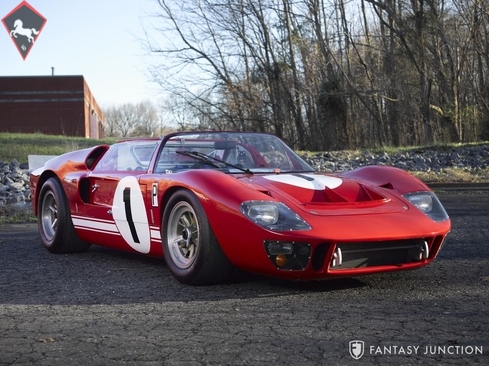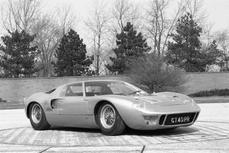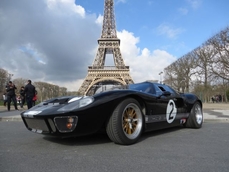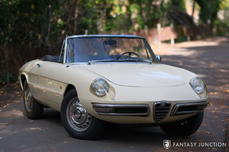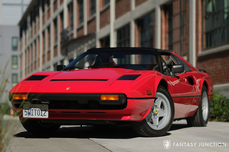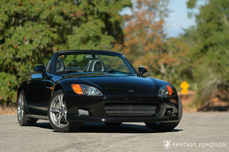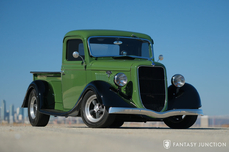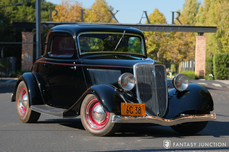Ford GT40 Ford V8 1966
General description :
1966 Holman-Moody Mk II Roadster
VIN - P-202
Engine - 427 V8
Transaxle - T-44 4-speed
Red with Black Interior
Highlights of this Holman-Moody Mk II Roadster
- Historically accurate roadster constructed by Lee Holman
- FIA eligible 7-liter with potential acceptance to world class events
- A superb Mk II proven with video track footage taken at Lime Rock
History of the Original Mk II
The 1960s was one of the most impressive decades of sports car performance engineering. Racing and production sports car development shared significant advances benefiting greatly from the overlap between advancing aerospace technology, material sciences, and horsepower wars. Conceived and developed by a Who’s Who of motorsports engineering, the Holman-Moody Mk II has become an American performance dreamscape, one that defines this extraordinary convergence of engineering, competition, and courage.
The origin of the Mark I and II is framed by Ford’s advances to Ferrari for a potential company purchase. After spending millions of dollars to investigate the financial health of Ferrari, Ford quickly learned of the challenges dealing with Enzo Ferrari. As negotiations advanced, CEO Henry Ford II was stunned when Ferrari pulled out of negotiations. The infuriated “Hank the Deuce” vowed to beat Ferrari at his own game, setting his sights and formidable resources on racing. After initial development in 1963, the first Mk I was completed in 1964, but arrived with less than promising results. Later that year, Ford delivered the project to Shelby American who would gradually improve the cars, refine the chassis, and begin establishing the Mk I as a force to be reckoned with. Eventually the more robust and highly capable Mk II would introduce the impressive Ford FE 427 big-block V8 mated to a T44 4-speed. The Mk II would rise to prominence, culminating in the 1, 2, 3 Le Mans photo finish that would captivate the world, becoming the subject of the award winning contemporary major motion picture film “Ford vs Ferrari”. In addition to the Le Mans sweep, the Mk II would bring Ford the 1966 Manufacturers Championship.
With significant differences in construction and performance, both the Mk I and Mk II occupy important places in the history of these great cars. However, the Mk II is considered the premier engineering example brought together by Carroll Shelby, Holman-Moody, Ken Miles, and a host of exceptionally talented team members, all of whom contributed to the success and legacy of these cars. The 427 powered Mk II not only allowed for 200+mph speeds at Mulsanne, the power and durability of the engine, 427 power handled by the Ford-developed T44 transaxle, robust monocoque structure, and larger brakes elevated the Mk II to the legendary winning status that built their vaulted worldwide reputation.
Holman-Moody History and Build Specifications
As the FIA manufacturer of record for Mk II cars, Holman-Moody remains today the only source for an accurate original build of the Le Mans winning Mk II. Today a genuine Mk II captures a rightfully important place in the pantheon of premier collector vehicles. And while a handful of contemporary shops offer kits that replicate approximate dimensions and performance of the original Mk I cars, only one company has the name, history, tooling, precise records, blueprints, and historic fabrication experience to faithfully construct a genuine race-ready continuation of the original Mk II – Holman-Moody of Charlotte, NC.
Operating today as an ongoing force in motorsports excellence, Lee Holman has continued the legacy of his father and partner developing the most accurate Mk II, an FIA approved Mk II of precise specifications. Constructed using the original blueprints for these ground-breaking cars, Holman’s cars use chassis fabricated by Tennent Panels, UK, the official supplier of Mk II chassis at the close of the racing program. and the original forming bucks to build the chassis for these specialized cars. Uninterested in building a copy or replica, every effort has been made to assemble the most original Mk II possible. When the owner of this car commissioned the build a few years ago, Lee Holman, at 6’ 2”, wanted to improve the fit of his personally configured Mk II. With Holman evaluating internal construction plans for a roadster, he suggested the roadster configuration for this build. Originally built as an experiment in lightweight construction, the Mk II roadster that was built in period, has not survived. This car is an exact continuation of that car, enhanced with only safety-related improvements.
Construction of this Holman-Moody Mk II roadster was performed at Holman over a period of over a year as Lee Holman, Jim Rose and other team members who were personally involved in the original Mk II build team crafted this car. Having retained an original and uniquely formed Mk II roadster windshield when Holman-Moody were building the five original Mk II roadsters, Lee Holman offered to build this first and only Mk II continuation roadster. As the first Mk II roadster was constructed using alloy panels for some of the structure, these riveted alloy panels quickly weakened under the rigors of Sebring competition. In this build, steel panels were used to form a safer and more durable monocoque structure. In addition to the Tennent Panels construction using original Ford jigs and tooling, the pressed steel monocoque structure was formed to specifications at Holman-Moody by Jimmy Tucker and Jim Rose, both of whom were members of the racing team for Ford at Le Mans. Further improvements were engineered into this roadster design including a full B column and chromoly bar fitted to the side and back edges of the windshield. Two removable side bars were also installed, linking the windshield structure to the rear brace. This closed roll bar construction allows acceptance to racetracks that require full roll bar protection and improves overall structural rigidity under the stresses of racing. Additional features further included relocation of a 1967 spec. dry sump oil tank now installed behind the driver instead of over the driver’s feet. Like many components on this car, the oil system itself is bespoke in detail consisting of a magnesium cast oil pan with gear-driven scavenge pumps inside the crankcase and Mk II B style aluminum rear oil tank.
This example was completed in 2020 and is outfitted with a host of exceptional features including a Jimmy Tucker built FE 427 medium riser cast iron block with aluminum heads and intake, single Holley 4-barrel carburetor, and dry sump oiling system, linked to a magnesium case Holman-Moody Kar-Kraft T-44 4-Speed transaxle. In addition to the numerous construction details surrounding this car, the build consists of Halibrand magnesium wheels with knock off hubs, and 2.260” stainless-steel “bundle of snakes” headers.
The independent double wishbone front suspension, anti-roll bar, adjustable shocks with coil over springs and double trailing arm rear suspension are identical to the original Mk II and use cast magnesium uprights at all four corners. Front and rear Girling CR type calipers and 11.56” ventilated disc brakes with Girling master, Aeroquip lines and fittings, are also interchangeable with original Mk II Holman-Moody cars. The fuel delivery system consists of two fuel cells, each with its own fuel pump. The overall development, refinement, and absolute adherence to the original design with further improvement for added safety and durability come together in a stunning presentation worthy of the Mark I and Mark II legacy, the legends that created it, and the heroes that raced these great cars to victory.
General Overview
Presenting with test mileage only and beautiful factory original finishes. This Holman-Moody Mk II roadster is exceptional at every level. Finished in gleaming red and white livery, reflective of the original Sebring roadster, no longer in existence, the white rocker panel stripes and #1 roundels depict the first roadster as it was when it won the 1966 Sebring race. The superbly crafted body panels feature all the hallmark Mk II features including NACA ducts, rear scoops, and side intake scoops. The glass, lenses, and exterior body trim are all in excellent cosmetic condition. There are no chips or scratches in the expansive wrap-around windshield, a unique and original unit specially constructed in the 1960s only for the roadster design. Fit and finish for the body panels is excellent throughout with exceptional stance and perfect wheel and tire fit. The Halibrand 8 x 15 rear and 6 x 15 front wheels feature center hub knock offs and Goodyear Blue Streak Sport Car Special tires. The total visual package delivers a menacing presence, finished off by a polished aluminum airfoil, in place for added high speed stability.
Stepping up to the driver’s door, the latch is easily accessed as the door swings open. In roadster configuration, the ease of entrance is greatly appreciated as the driver and passenger slip into the cockpit. The removable steering wheel further improves ingress and egress. The seating position has been improved significantly under 6’ 2” Lee Holman’s direction inviting owners of taller stature to enjoy the magic of these cars. The interior displays historically accurate finishes including ventilated seats, displaying the now iconic brass grommet ventilation holes, which are historically accurate. The current seats also are padded to provide a more upright driving position since the original laid-back position is no longer required by a low roof. The.race-specification dashboard, internal build details, exposed rivet construction, offside gear selector, correctly labeled toggle switches, correct instrumentation, and Sparco multi-point seat harnesses all convey the power and performance of this rare roadster.
Lifting the hinged clamshell rear deck, the ground-breaking 427 V8 engine is a feast for the eyes. Though it’s difficult to decide where to look first, the warmly hued stainless-steel bundle-of-snakes exhaust commands your attention, exiting just under the aluminum heads, rising to gather over the T-44 magnesium case gearbox. The massive rear tires, exposed coil-over suspension, flanking twin pumps and Holman-Moody 427 branded valve covers deliver a satisfying narrative celebrating the historic excellence of these great cars. The removable front cover reveals a clean and tidy forward bulkhead containing a FireSense fire bottle feeding the fire suppression system plumbed throughout the car. The entire front section can also be removed which reveals twin electric cooling fans. Fluidyne High Performance radiator, and internal air ducting. The sophisticated engineering and artful construction are evident in every weld line, rivet, and carefully placed lightening hole – true to the original in every respect. The undercarriage displays evidence of the original construction methods employed to create the sophisticated welded steel monocoque. Suspension and various exposed components are further in excellent condition including the cast magnesium oil pan, magnesium cast gearbox, sophisticated suspension uprights, half shafts, coil-over shock absorbers, and Girling disc brakes.
The car starts easily, setting off a raucous V8 sound that goes straight to the soul of any motorsport’s enthusiast. Once warmed, the settled idle lopes in waiting, eager for higher revs and track action. Seating position is excellent with great forward visibility and command over the mid-engine layout. As use is primarily focused on racing venues, power comes on immediately as an unforgettable rush of 427 power vaults you forward. It’s hard to imagine how even masterful drivers might have commanded such power at full tilt, subjected to hours of racing, but this is one of many reasons why nearly all these great drivers are known as heroes of this era.
This rare and amazing Holman-Moody constructed Mk II roadster is offered with a car cover and bag, removable roof side roll bar connectors, and a plaque for display by the current owner when presented at The Quail, Monterey, CA.
One of the most sought-after collectible premium supercars in the history of modern competition motorsports, this Holman-Moody Mk II roadster offers enthusiasts a unique opportunity to experience every aspect of the original construction without the costs, frailties, and concerns associated with museum artifacts. With original Mk II examples now multi-million-dollar icons, this rare example is ready to deliver exceptional performance and provenance. Hand fabricated by members of the original Holman-Moody Mk II build team, with single commissioned ownership, this is a rare opportunity to own a very special vehicle, one that continues the legendary legacy of the incomparable Mk II and the courageous engineers and builders that made history with these exceptional cars.
This car has been designed and built for competition use specifically for closed course racing. It is offered on Bill of Sale only.
1966 Ford GT40 Ford V8 is listed for sale on ClassicDigest in California by Fantasy Junction for Not priced.
Car Facts
Car type : Car Make : Ford Model : GT40 Model Version : Ford V8 Engine size : 0.0 Model Year : 1966 Location : Emeryville Vehicle Registration : Normal
Not priced
Seller Information
Fantasy Junction
Fantasy Junction
+1 510 653 7555
Fantasy Junction
+1 510 653 7555
People who viewed this Ford GT40 also viewed similar Ford listed at ClassicDigest
Other cars listed for sale by this dealer
About Ford
Ford, founded in 1902, has arguably changed the history of automotive world more than any other car manufacturer by introducing the first people's car Model T in 1908. They had produced more than 15 million cars by the end of the production in 1927, by which T had become obsolete.Ford launched the first low priced V8 engine powered car in 1932. 1932 V8 was an instant hit with superior handling and performance to many far more expansive cars of the day. No wonder 32 V8 Ford has become such a favourite among hot rodders around the world with 32 Deuce coupe as their icon.
During the war Ford completely shut down civilian vehicle production to dedicate all its resources to the Allied war efforts (1942-45) They used to build B-24 bombers, aircraft engines, jeeps, M-4 tanks, military trucks and Bren-gun carriers and more than 30,000 super-charged Rolls Royce Merlin V-12 engines for Mosquito and Lancaster bombers as well as P-51 Mustang fighters. After the war Ford cars in the USA got bigger and flashier along with their competitors. In the 60's Ford was back in the forefront again when introducing their commercial hit Mustang in 1964. Mustang was so popular the competition had to follow Ford's example and the ponycar phenomenon took over the US. Over the years the ponies grew some muscles until the oil crisis kill finally killed them off.
In the sixties Ford rushed into international motor sports scene with a fury. After unsuccessful Ferrari takeover, when Enzo Ferrari had cut the deal off with Henry Ford II making the latter absolutely boil with fury, Ford turned to Lola in UK to produce a Ferrari beating long distance racer after. The collaboration between Ford and Lola created the mighty Ford GT40 that absolutely beat Ferrari in Le Mans 24 numerous times.
In Europe, Ford introduced some of the most epic race and rally cars of the 60's based on humble family sedans; Cortina GT, Lotus Cortina, Escort Twin Cam, and Escort 1600RS with the iconic Cosworth BDA engines.
Today classic Fords are extremely popular with enthusiasts and a great selection of classic Fords can be found for sale at www.ClassicDigest.com
